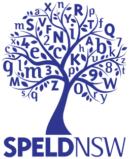You might know irregular words as inconsistent words, sight words, or tricky words but basically, we would define them as any word that cannot be read using the most likely grapheme (letter or letter group) to phoneme (sound) correspondences (GPCs). We sometimes hear from teachers that the reading program they use teaches that there is no such thing as an irregular word. We are often asked at SPELD NSW if we agree with this idea and our response is that it’s a little more complicated than that.
English consists of 44 phonemes and at least 250 graphemes – if we count some of the less common ones there may be double that number. When we first start to teach children to read, we start by teaching one phoneme for each grapheme that we introduce. We later teach that graphemes may represent alternative phonemes (e.g., the letter ‘a’ sounds different in ant and baby), and that some phonemes may be represented by more than one grapheme systematically over time (e.g., the /ai/ sound is represented by ‘a’ in baby, ‘ai’ in paint, and ‘ay’ in play). English orthography (the letter system that is used to represent the English language) is uniquely complex, which is why we spend much of the first two to three years of school explicitly teaching this code. However, research has found that phonics programs that explicitly teach that there are two or three ways of representing each phoneme are as effective as those that onerously teach all 250+ possible variants. This is because once children understand the reading process, they can ‘self-teach’ new GPCs as they encounter them in text. Explicit teaching is no longer necessary.
Because it is not necessary to teach all GPC variants, we need to focus on those that are seen most in print. Here’s an example: If we explicitly teach, e.g., ‘ey’ as a regular alternative for /ai/, then we are opening the possibility that children may consider ‘ey’ an equally feasible alternative to ‘ay’, when actually it is more commonly seen to represent the /ee/ sound, e.g., in words like key and money. Because of this, we should introduce ‘ey’ in the context of the few irregular words in which it is relevant (e.g., ‘they’, ‘grey’, and ‘hey’) and introduce the few other words in this group as vocabulary words if they come up within a topic (e.g., ‘obey’, ‘prey’, ‘survey’). It is much better for students to understand ‘ey’ as an irregular alternative for /ai/ because if they want to write a word with /ai/ in it, we want them to only go to ‘ey’ for those very specific words. If they read a new word with ‘ey’ in it, we want them to choose the phoneme option /ee/, because that’s more common.
There is a second aspect that is really important to consider here when considering whether a word is ‘irregular’, I want you to think about a word that you have accidentally – and perhaps embarrassingly- mispronounced in the past. You will inevitably find that every one of those words meets two criteria: Firstly, it has an orthographic structure that means it could be pronounced in more than one way (mauve, quasi, quinoa, epitome, hyperbole, and segue are just a few that commonly seem to trip people up) but secondly – and here is the important bit – it is likely to be a word that you have rarely or never heard spoken aloud and that you almost inevitably learned through your reading. Would learning every single spelling option for every single phoneme have helped you pronounce the words above accurately? No! In order for you to know how to pronounce the word it MUST be strongly established in your oral vocabulary when you first read it. What would have helped a lot more is for you to have learned these words through a strong vocabulary program, emphasising morphology and etymology, and based within oral reading and rich literature experiences.
When we say ‘there are no irregular words’ we’re being ingenuous. Phonics instruction alone cannot regularise every word in English. However, with planned, systematic introduction of irregular words within the wider literacy block, we can embed irregular word learning into our teaching practice.




